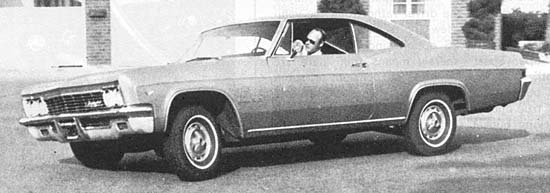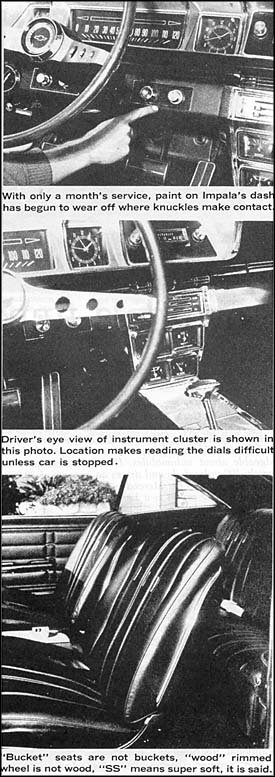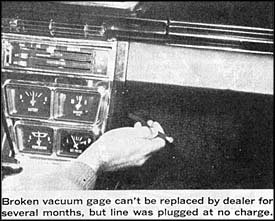

| Editor's note: Mr. Evans is an instructor at Orange Coast College, Costa Mesa, California. He is a former member of the board of directors of the Southern California Region of the Sports Car Club of America, has had considerable racing experience and is quite knowledgeable about automobiles. He commutes approximately 100 miles daily and drives an average of 30,000 miles per year. The Mercedes he refers to in this humorous little report is a 190 sedan which preceded his leased Impala. |
| A few weeks ago, I became the new lessee of a 1966 Chevrolet Impala. This automobile is not exactly the one I would have selected as an ideal vehicle, but the economics of leasing dictated the choice. The lease payments are based on the value of the car at the end of the lease period. The Impala has the highest resale value in its class, or, to put it another way, it depreciates the least and certain accessories enhance the resale. So, the car is "loaded," as auto salesmen like to say. In other words, there are loads of accessories.
Some of these accessories, which raised the base price of around $3000 to a sticker price of over $4100 include: 327 V8 engine, 2-speed automatic transmission, a heater-air conditioner combination, additional instruments, individual "bucket" seats, "wood"-rimmed steering wheel, power brakes, power steering, radio plus a few others. Having used a 1965 Cadillac considerably during the past year, I was glad that the tilting and telescoping steering wheel is offered as a Chevrolet option this year. I have found this feature enjoyable, particularly on long trips. But attempting to actually order this on an Impala apparently presented insurmountable difficulties. Although the salesman smiled and nodded to all my requests for options, when the time arrived to actually write up the order, a young lady was summoned to the office carrying an impressive-looking volume of factory data. I was informed that she was the expert on ordering options. After a few hours and many cups of coffee, it developed that, (I think): a. If you get the wood rimmed steering wheel, you can get the tilt, but not the telescopic feature (or it may be the other way around).I thought the instrument cluster would be nice because without it, all indications other than fuel and the time of day are just little lights. As it turned out, the instruments are located in such a place that it is necessary to stop the car in order to observe them. I must say though, that the clock is readily observable. This must be an advantage for those without wrist watches. (The clock, so far, has worked quite well and is very accurate.) |
| The car is designated a "Super Sport." (I always
thought the term was "super sports," but maybe they are referring to the driver rather than the vehicle.) Having owned a few sports cars I was a little disappointed in the SS option since it turned out that "Super Sport" merely means that there are "bucket" seats not superior suspension or some such. I put the bucket in quotes because the seats are not true buckets. Be that as it may, it developed that having bucket seats also affected whether or not I could have a tilting and/or telescoping steering wheel.
About this time I retired to a nearby establishment to contemplate the matter over a delightful mixture of Kahlua and Vodka. After a while, I ceased to care as much about the whole thing and decided to take whatever car was in inventory, rather than argue with a computer. The "wood"-rimmed steering wheel is very nice and I do enjoy it. (The "wood" isn't true wood, either.) After driving the car ten miles or so, a curious rattle developed, (sort of like a death rattle), somewhere on the dashboard. The dealer is located less than a mile from where I work, so I took it in to be fixed and left the car. Three days later, I was told that the rattle was in the vacuum gage. "Fine," I said, "Put in another one." A lengthy conference with the parts man disclosed the fact that the new gage could be expected sometime in March, (maybe). Since this gage is not readily visible while operating the vehicle anyway, I asked them to disconnect it. This they were amenable to doing because, as they explained, the only reason there was a vacuum gage in the first place was to fil a hole in the instrument cluster panel. Next, I drove the car on the freeway. In the 50 to 70 mph range, the roar of wind noise made conversation or radio listening difficult. Since the wind noise came from both sides of the car, at least it was in stereo. This time the trip to the dealer took only three minutes. It was explained to me that this is the way they are, an act of God, (or a General, in this case). After some practice, I found I could block the wind noise out mentally so that I could discern other sounds. One of the more delightful of these turned out to be creaking windshield posts. I haven't got up the courage yet to approach the dealer about this. Chevrolets are advertised as "jet smooth," and I was looking forward to comparing this with the Mercedes. On very smooth surfaces the ride is indeed, jet smooth. Unfortunately, many of our freeways are constructed of concrete. I had heard about "freeway hop," but had not experienced this phenomenon with the Mercedes. |   |
| After traveling over the same surfaces at the same speed in both cars, I can only conclude that the engineers who designed the Chevy suspension system have cleverly taken advantage of "freeway hop," in their configuration and built it in irrevocably.
I have driven in a few sports car racing events and I didn't expect a sports car, even with the "super sport," designation. But I have found it prudent to try to discover the limitations of a car in the handling department so that when an unexpected driving situation develops, I have an idea of how the car will act. My usual practice is to start to push a car, at ever increasing speeds, through a familiar corner. The idea, of course, it to discover the limits of adhesion, or when it will start to spin out. It is not necessary to actually spin out, because you can correct it at this point, but at least you know. I was soon disabused of that notion with the Impala, however. In anything approaching what seems to me a reasonable cornering speed, the car heels over much like a sailboat. Maybe if I could get some friends to crew for me and hang over the other side, the heeling could be counterbalanced. Since I sometimes like to drive with my left arm out the window, I have given up the idea of rapid cornering in order to avoid scraping my elbow. Anyway the car gives me the feeling that it would much prefer to turn over on its top than spin out. The brakes seem to do an adequate job on a single stop, except for locking the right rear wheel rather easily. I know they have all the inherent faults of drum brakes, so when I ordered the car, I wanted to specify disc brakes - assuming that by now these vastly superior brakes would be at least available as an option. This turned out to be an incorrect assumption insofar as the General is concerned. (I do have tinted glass though, which must be one of those safety features developed on the famous proving grounds.) I didn't really want to drive in the mountains anyway, and if it rains, I'll just stay home. On the first three tanks of gas, I checked mileage. On mostly open road driving, it developed I was getting around 15 mpg. I used to have a Chrysler 300 which did about as well; but then the Chrysler would run off and hide from just about anything else. I took the car back, (again), for a conference at the dealer's. The head of the new car "prep" department had just completed a course in 1966 Chevrolets conducted by the factory. The upshot of the information he received in this course seems to be that mechanics should not "tinker" with the engine. I was assured that I should be happy with 15 mpg and that anyway, if all is not right in the engine department, it is the fault of the California Legislature for requiring smog control devices. My first night driving experience resulted in the observation that the bulb which lights up half of the speedometer was inoperative. I was greeted at the dealer's with the information that 1966 models have all "new type" bulbs and that replacement bulbs are expected any month now. About this time, I was glad I had instruments, (even if one doesn't work), rather than all the little lights. The "prep" manager finally confided to me that the way he solves his spare parts problems is by cannibalizing unsold new cars. Maybe the buyer won't notice that particular deficiency. And, if he does, well, there are always more new cars coming in. (It's certainly reassuring for the driver of a domestic car to know that parts are readily available; whereas with those funny furrin ones, you never know.) Today I got a post card that my new metal license plates are at the dealers and would I please come in so that they can be installed. So now I'm off to the hardware store for nuts and bolts, just to be on the safe side. In an overall rating of the car, the highest mark has to go to the low comparative depreciation. Also, in spite of the factory, the dealer and his staff were very courteous and cooperative. Creature comforts are well taken care of, and the car is pleasant to look at. The famous 327 engine is both docile and powerful. Sometime it idles roughly, especially with the air conditioner on, but then the idle adjustment is one of those things that can't be "tinkered" with. Mechanically, the engine is the best part of the car. The air conditioner-heater is a vast improvement over separate units. Suspension, brakes and body construction have to get "Ds" while spare parts, an "F". All in all though, I'm happy with the car. The lease will expire before the guarantee. And on April 15th, I'll be happiest of all. |